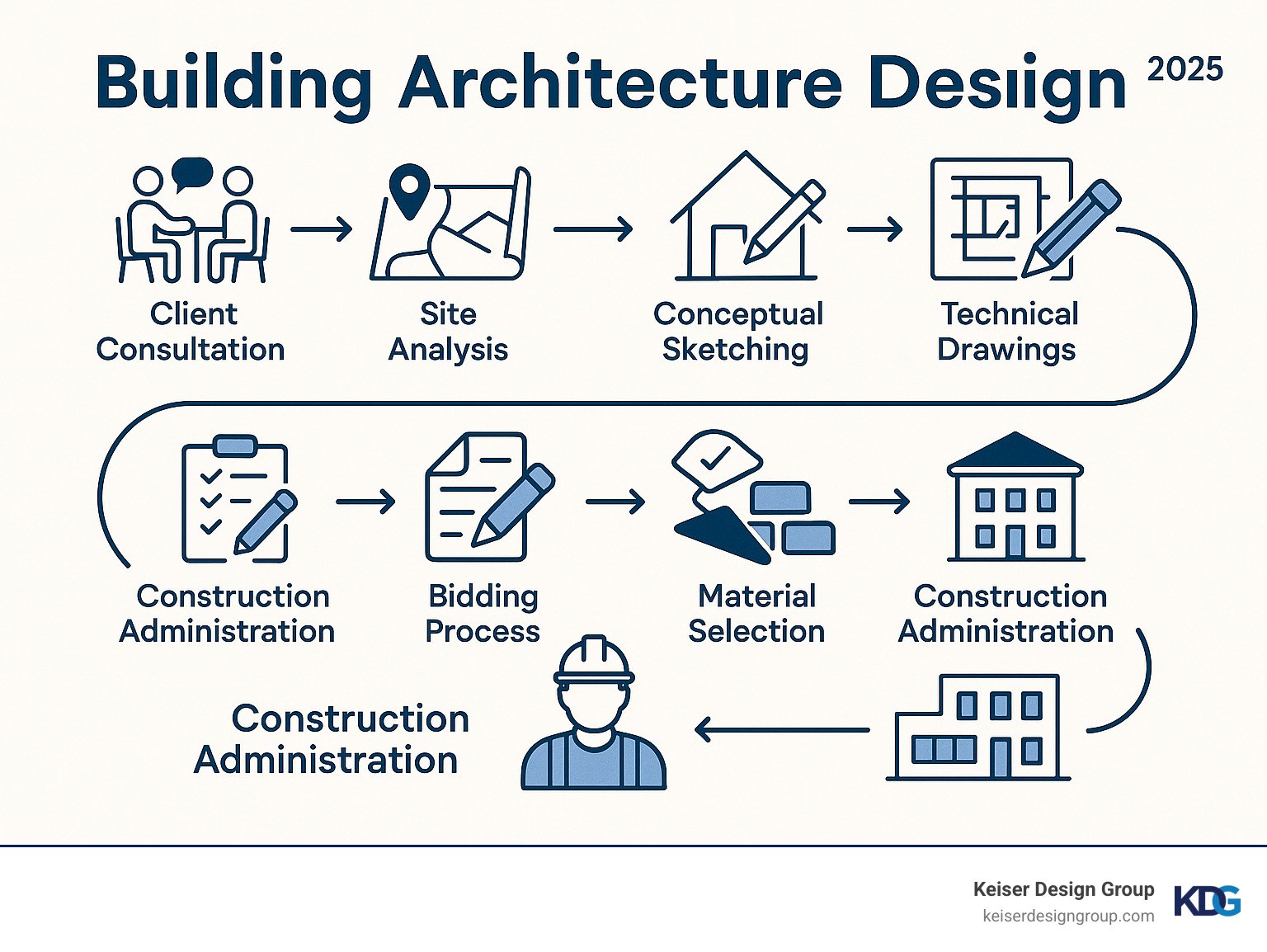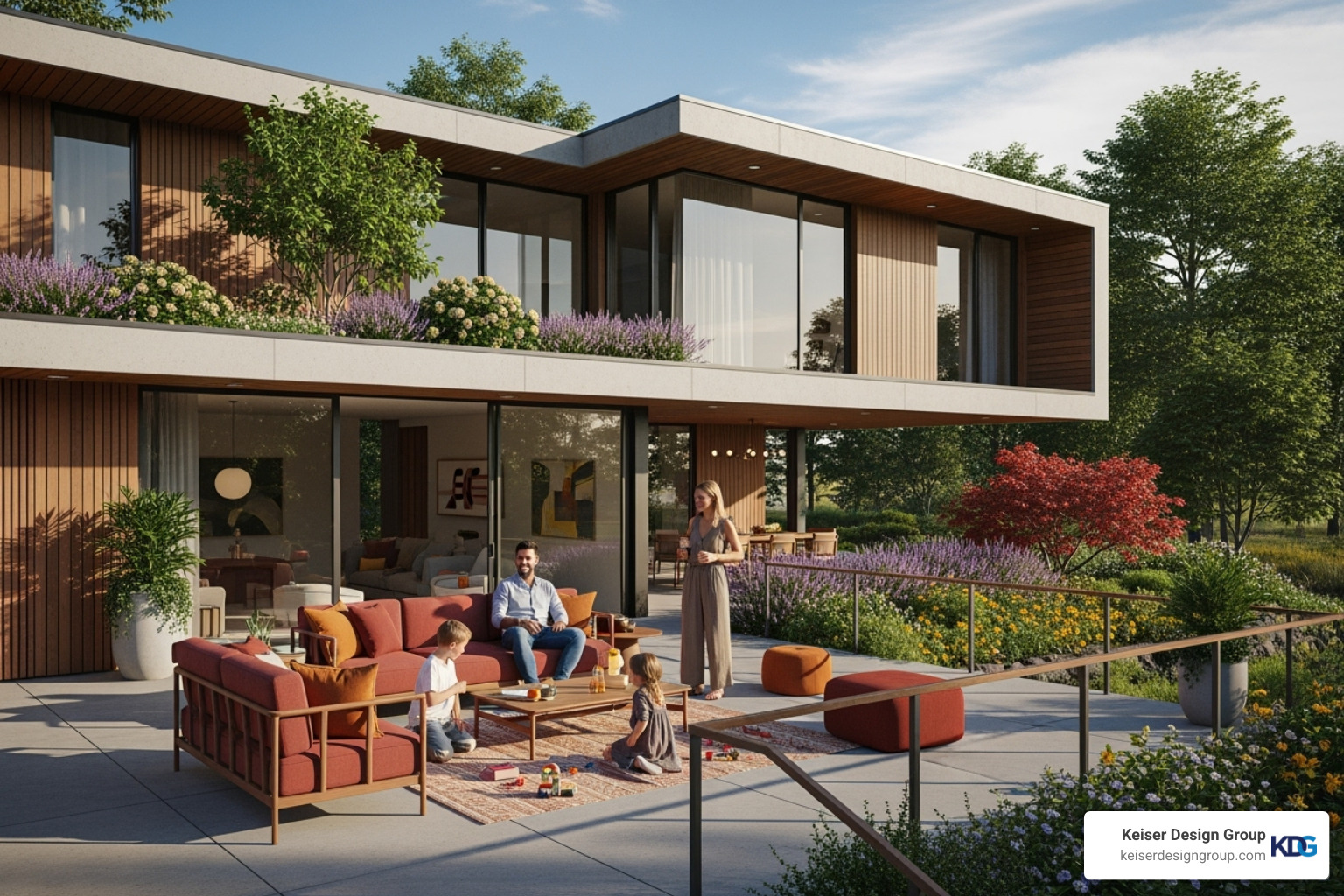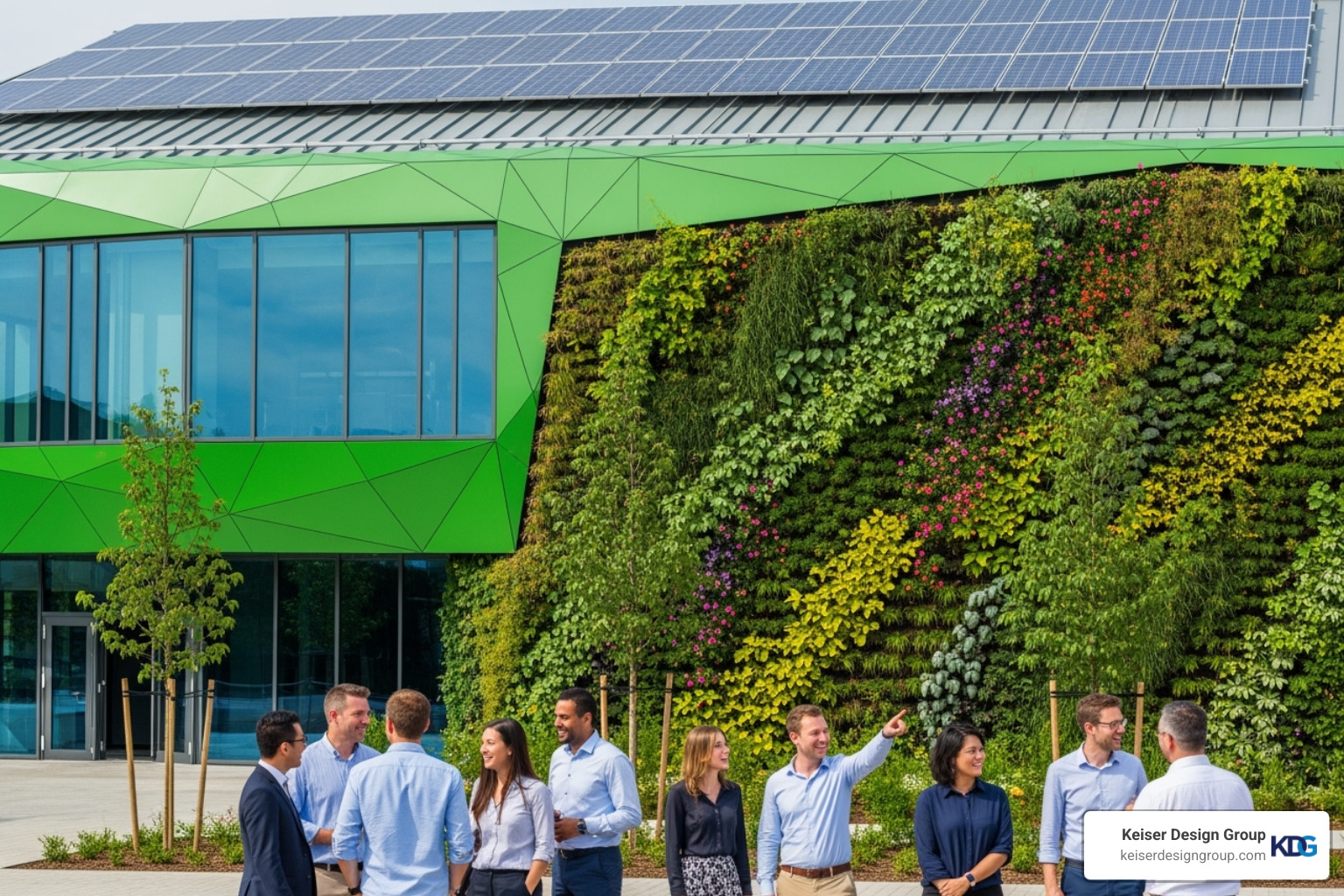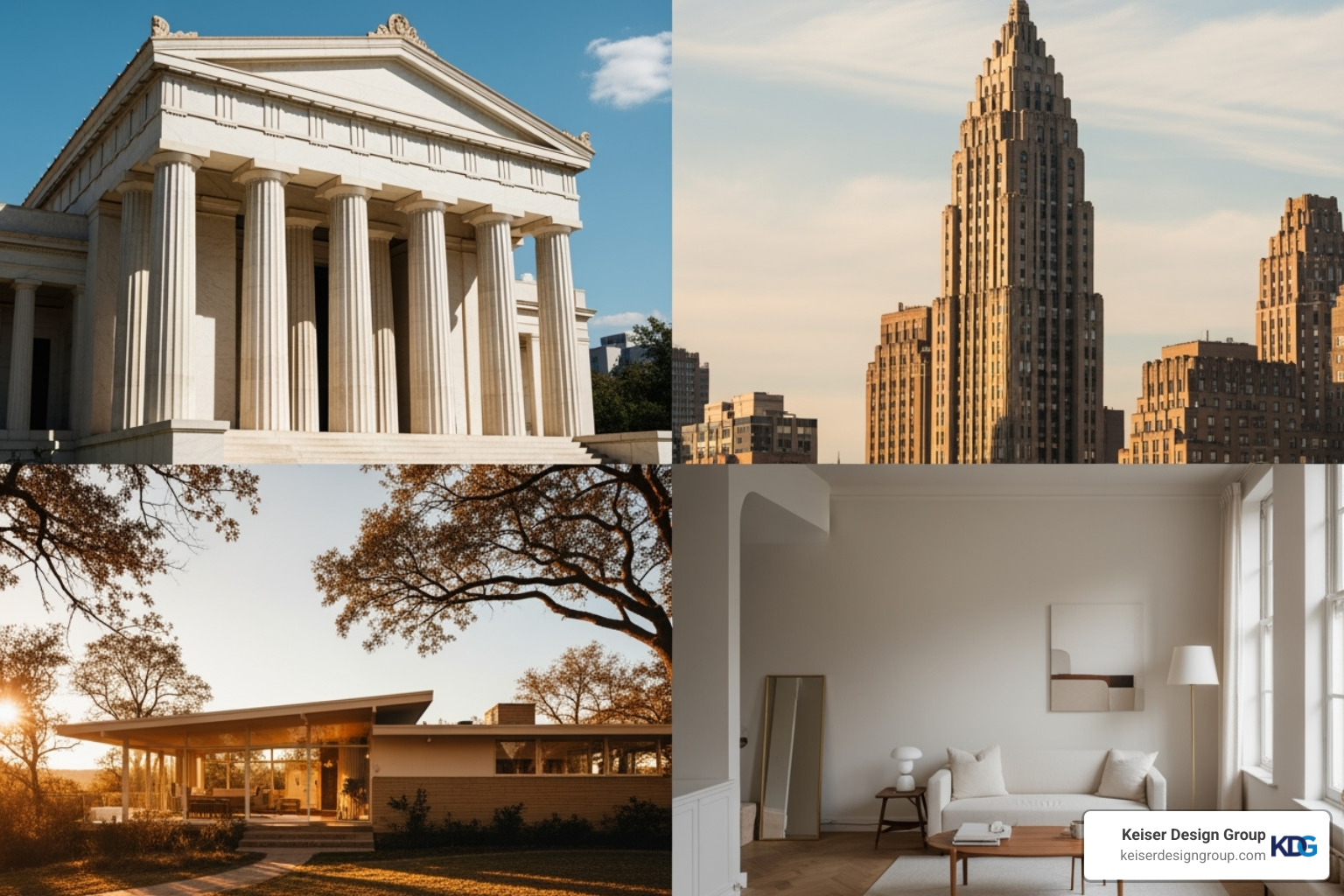Why Building Architecture Design Matters More Than Ever
Building architecture design is the art and science of creating functional, beautiful, and sustainable structures. It combines creative vision with technical expertise to transform ideas into reality, shaping how we live, work, and interact with our environment.
Valued at $139.5 billion in 2023, the global architectural services market highlights the demand for thoughtful design. Today’s architects steer complex challenges, from achieving 25% energy savings in LEED-certified buildings to integrating technology in the projected $100.7 billion smart building market.
Modern architecture has evolved beyond shelter to address climate change, accept technologies like AI and Building Information Modeling (BIM), and respond to new lifestyle needs. The journey from concept to construction requires balancing artistic vision with practical constraints like budget and building codes to create spaces that are beautiful, functional, and sustainable.
I’m Dan Keiser, founder of Keiser Design Group. For over three decades, I’ve guided clients through the building architecture design process, from initial concepts to construction completion. My hands-on approach ensures every project reflects both creative excellence and practical expertise.

The Language of Architecture: Core Elements and Guiding Principles
Just as writers use words, architects use specific building architecture design elements and principles to create spaces that communicate. Understanding this architectural language helps you appreciate why certain buildings feel calm, energized, or inspired. It’s the difference between a random collection of materials and a thoughtfully designed space.
The Building Blocks: Fundamental Design Elements
Every great building starts with the same basic elements. These are the universal tools architects use to create meaning.
Line forms the foundation of architectural expression. Vertical lines suggest strength, horizontal lines create calm, and diagonal or curved lines add energy and flow.
Shape and form define a building’s two-dimensional outline and three-dimensional presence. Form is how a building exists in space, with light and shadow creating depth.
Color and value dramatically change how spaces feel. Cool colors can make a room feel larger, while warm colors create intimacy. Value—how light or dark a color is—also shapes the mood.
Texture engages both sight and touch. The rough grain of wood creates warmth, while smooth metal feels clean and modern. Texture affects acoustics and comfort.
Proportion ensures buildings feel right for human scale. The relationship between the size of different elements makes spaces feel natural and comfortable.
Space is what architecture shapes. We design empty areas to create experiences, from cozy nooks to grand halls. The connection and flow between spaces are central to great design.

To see how these elements combine in real homes, check out How Residential Architecture Shapes Our Daily Lives.
The Grammar of Creation: Key Architectural Principles
Principles organize the basic elements into something beautiful and functional. These flexible tools help us solve design challenges.
Balance creates visual stability by distributing visual weight so a design feels settled and in equilibrium.
Symmetry and asymmetry are two approaches to balance. Symmetrical designs are mirrored and formal, while asymmetrical designs use different but complementary elements for a more dynamic feel.
Axis is an invisible line that organizes a design, guiding the eye and movement through a space, such as down a long hallway or up a grand staircase.
Emphasis directs attention to important features, like an entrance or fireplace, using contrast in material, lighting, or scale to create a focal point.
Rhythm is the repetition of visual elements, like windows or columns, to create a pattern that gives a building a sense of unity and flow.
Unity and contrast work together for a cohesive design. Unity ensures all parts feel like they belong, while contrast adds visual interest and highlights key features.
These principles guide us in creating building architecture design that’s not just functional, but meaningful. For more insights, explore More info about residential architecture design.
The Architect’s Journey: A Step-by-Step Building Architecture Design Process
This guide walks through the distinct phases of an architectural project, from the initial client conversation to the final constructed reality. The building architecture design process is a logical progression broken into three main phases, starting with big ideas and ending with fine details.
Phase 1: The Spark of an Idea – Pre-Design and Conceptualization
This first phase is about understanding your story and setting the stage for the project.
- Client Brief: We begin with a deep dive into your needs, wants, and goals. We want to understand who will use the space and how, often using mood boards to clarify the vision.
- Site Analysis: We study your property to understand sun exposure, views, drainage, and neighborhood context. The building should feel like it belongs.
- Zoning & Codes: We research local regulations like setbacks and height limits to ensure your project is feasible. This is a puzzle of fitting your vision within the rules.
- Budgeting: A realistic budget is established early on. It’s a critical tool that guides smart decision-making throughout the entire process.
This groundwork shapes every decision that follows. You can read more in The Spark of an Idea and Regulations vs Vision.
Phase 2: From Sketch to Blueprint – Design Development
Here, we translate ideas into tangible plans through an iterative and collaborative process.
- Schematic Design: We start sketching and creating simple models to explore different concepts and find the central idea, or “parti,” that drives the design.
- Design Development: With the concept set, we refine the details. We select materials, define building systems (like HVAC and electrical), and finalize the floor plans and elevations.
- Construction Documents: We create a detailed set of drawings and specifications that serve as the instruction manual for the contractor. These documents guide the entire build.
- Material Selection: We choose materials based on aesthetics, performance, durability, and cost, ensuring they align with the design intent and your budget.
Learn more about our approach at Visualization and see commercial project considerations in Five Phases of Commercial Building Design.
Phase 3: Breaking Ground – Bidding and Construction Administration
With blueprints complete, it’s time to build. We remain your advocate throughout construction.
- Bidding & Negotiation: We help you find the right contractor by managing the bidding process, evaluating proposals, and clarifying the design for potential builders.
- Construction Oversight: We visit the site regularly to ensure work aligns with the construction documents, review material samples, and solve problems as they arise.
- Project Completion: We assist with final inspections, create a “punch list” of remaining items, and facilitate the final handover of the completed project.
Read more about this exciting stage in Groundbreaking Moment.
Shaping the Future: Modern Influences and Key Considerations
Contemporary building architecture design goes beyond aesthetics to address global challenges and technological advancements. As architects, we weave sustainability and cutting-edge technology into every project, recognizing that every design decision is an opportunity to make a positive impact.
Designing for Tomorrow: Sustainability and Green Architecture
The construction industry accounts for roughly 40% of global carbon emissions, giving us a significant opportunity to create change through thoughtful design.
Energy efficiency is a primary goal. We use passive design strategies—like orienting a building to optimize sun exposure and natural ventilation—to reduce energy consumption. LEED-certified buildings, for example, save an average of 25% on energy costs, and we guide clients through the LEED certification process to achieve these benchmarks.

Sustainable materials are chosen for their low environmental impact. We prioritize locally sourced, reclaimed, and renewable materials to reduce a building’s carbon footprint across its entire lifecycle. We also explore innovations like modular construction, a market projected to reach $257.9 billion by 2027, which minimizes waste and improves efficiency by prefabricating components off-site.
For more on sustainability, explore Architectural Sustainability with Permaculture and our approach to Future-Ready Homes: How Contemporary Residential Architecture is Shaping Tomorrow’s Living Spaces.
The Digital Blueprint: Technology’s Impact on Building Architecture Design
Technology has transformed how we design and construct buildings. The global smart buildings market is expected to reach $100.7 billion by 2028, reflecting a demand for more intelligent and responsive structures.
- Building Information Modeling (BIM): BIM creates a digital twin of a building, containing comprehensive data on every component. This allows us to identify potential conflicts before construction, improving coordination and reducing errors.
- Virtual and Augmented Reality (VR/AR): These tools allow clients to virtually walk through their future building, providing a clear understanding of the space that 2D drawings cannot match.
- Artificial Intelligence (AI): AI is an emerging partner that helps us optimize designs, from analyzing environmental data to refining structural systems for lower embodied carbon.
- Smart Buildings: We integrate systems for automated lighting, climate control, and security that learn from occupancy patterns to improve efficiency and user comfort.
Technology opens up new possibilities for creating intelligent and deeply human spaces. For more on our commercial work, visit More info about commercial architecture design.
A Tour Through Time: Exploring Architectural Styles
Understanding historical styles provides context for today’s designs and offers a rich palette of inspiration. Building architecture design is a visual timeline, with each era leaving its unique fingerprint on the structures around us. Recognizing these styles helps inform the vision for your own project.

Classic and Revival Styles
These movements drew inspiration from ancient Greece and Rome, emphasizing symmetry, proportion, and order.
- Greek Revival (1820-1860): Features temple-like fronts with classical columns (Doric, Ionic, Corinthian) and wide pediments, conveying dignity and permanence.
- Romanesque Revival (1840-1900): Characterized by monochromatic masonry, semicircular arches, and sturdy square towers, creating a sense of solidity.
- Neoclassicism (1900-1940): A revival emphasizing clean lines, symmetrical facades, and colossal columns for a look that is both modern and timeless.
- Beaux Arts Classicism (1890-1930): Known for grandiose compositions with projecting facades, paired columns, decorative statuary, and monumental staircases.
Modern and Contemporary Movements
The 20th century ushered in a revolution, with architects rejecting historical styles in favor of new forms driven by new materials and social values.
- Art Deco (1925-1945): Celebrated the machine age with bold geometric patterns, vertical emphasis, stepped facades, and zigzag motifs.
- Mid-Century Modern (1950-1979): Focused on clean lines, expansive windows, flat roofs, and open floor plans, with a strong connection between indoors and outdoors. This includes the unadorned International Style and the massive concrete forms of Brutalism.
- Minimalism (1960s-Present): Follows a “less is more” philosophy, creating calm spaces with clean lines, open plans, abundant natural light, and a simple material palette. Decoration comes from proportion and light, not applied ornament.
For more on residential styles, explore Popular Residential Architectural Styles. For commercial trends, see Top 7 Design Trends for a Modern Commercial Building. For a comprehensive visual guide, Explore different architectural styles.
Frequently Asked Questions about Building Architecture Design
Here are answers to some of the most common questions we hear about the building architecture design process.
How do architects balance a client’s vision with practical constraints like budget and building codes?
This is the core of our job: translating your vision while navigating the realities of budget, zoning laws, and building codes. We treat constraints not as limitations, but as catalysts for creative problem-solving. Through honest budget conversations, phased design, and value engineering (finding smart alternatives that maintain design integrity), we find innovative solutions. Clear communication is key, as we keep you informed of trade-offs and options at every step to ensure the final design is both inspiring and feasible.
What are the most important skills for a successful architect?
While creativity is essential, a successful architect needs a diverse toolkit:
- Problem-Solving: Every project is a unique puzzle of site conditions, client needs, and regulations that requires creative solutions.
- Communication: We must clearly translate abstract ideas into concrete plans and facilitate collaboration between clients, engineers, and contractors.
- Project Management: Orchestrating dozens of moving parts, from schedules to consultant coordination, is critical to keeping a project on track.
- Visualization: The ability to see and feel a space in three dimensions before it exists is fundamental to our work.
- Empathy: Understanding how people will use and experience a building is what transforms a structure into a truly responsive space.
How long does the architectural design process typically take?
The timeline for building architecture design varies significantly based on a few key factors: project scale and complexity, client responsiveness in decision-making, and the speed of the local jurisdiction’s permit review process.
A simple residential addition might take a few months to design, while a large commercial building can take a year or more before construction begins. A typical project breaks down as follows:
- Pre-Design & Conceptualization: 1-2 months
- Schematic Design: 1-3 months
- Design Development: 2-4 months
- Construction Documents: 3-6+ months
- Bidding & Construction: Varies from months to years depending on project size.
We provide a realistic timeline from the start to help you plan accordingly.
Conclusion
Meaningful building architecture design is a journey that transforms a spark of an idea into a structure that serves people in their daily lives. It is a discipline that marries the art of design—line, form, and color—with the science of engineering, code compliance, and sustainable practices.
The process requires a methodical approach, from initial site analysis to final construction oversight. Modern architecture accepts the challenges of our time, integrating sustainability to reduce our environmental impact and using technology like BIM to design with greater precision. By learning from historical styles while looking to the future, we create buildings that are both timeless and responsive.
At Keiser Design Group, we have spent over three decades perfecting this balance of creativity and practicality. We specialize in a streamlined, worry-free process, handling the complexity so you can focus on the excitement of seeing your vision come to life. Our passion is crafting experiences, solving problems, and improving how people live and work.
Explore our architectural services to start your project and find how we can transform your vision into a thoughtfully designed reality.


